Letters from Lodi
An insightful and objective look at viticulture and winemaking from the Lodi
Appellation and the growers and vintners behind these crafts. Told from the
perspective of multi-award winning wine journalist, Randy Caparoso.
Winemakers and journalists taste and talk about aged Lodi wines, up to 27 years old
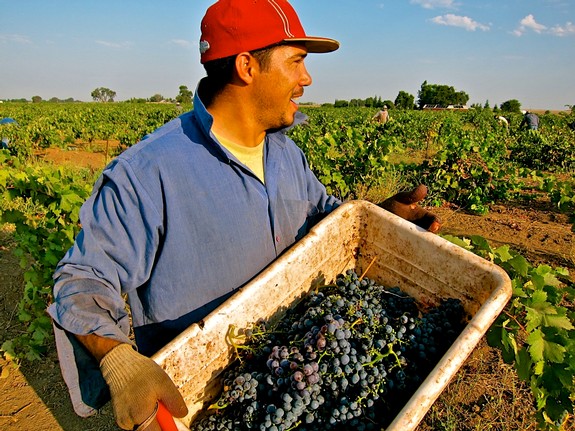
Zinfandel from Turley's 2010 Dogtown Vineyard harvest, going into a bottling tasted and discussed this past week, nearly 14 years later.
Last week (May 14, 2024) a most unusual Lodi tasting (even for us!) was conducted, per the request of four visiting journalists representing Wine Enthusiast magazine: Tonya Pitts (Contributor, Wine Reviewer), Anna Christina Cabrales (Tasting Director), Sara Ventiera (Senior Digital Editor) and Anthony Eyzaguirre (West Coast Advertising Account Manager).
We tasted 14 Lodi-grown wines from vintages going back as far as 1997 (coming up on 27 years old).
The visiting editors were curious about two things: 1) do Lodi wines age well?, and 2) if so, how?
Presenting all the wines were four winemakers associated with the brands in question:
• Heather Pyle and Eliza Hess, The Lucas Winery
• Stuart Spencer, St. Amant Winery
• Tegan Passalacqua, Turley Wine Cellars
Needless to say, much of the commentary proffered by our esteemed panel of vintners are worth documenting and pondering for future reference, which we will share in this post following my own notes on each wine.
The short answer to the visitors' question, to begin with, is this: Yes, Lodi wines do age well, probably in ways that may surprise even the most experienced wine lovers or connoisseurs.
We're not saying all Lodi wines can gracefully mature and improve in the bottle for longer than 10 or 20 years, but there are those, grown and crafted under special circumstances, that seem to do exactly that, and quite effortlessly.
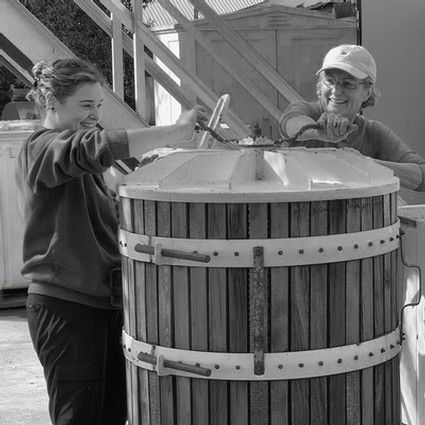
The Lucas Winery's Heather Pyle (right) with her assistant winemaker Eliza Hess.
Notes on older Lodi vintages
First, abbreviated notes on the wines, all Zinfandels, tasted during a roundtable discussion:
2000 The Lucas Winery, ZinStar Vineyard Mokelumne River-Lodi Zinfandel⏤Beef bouillon-like aroma laced with kitchen spice, black tea and faintly herbaceous scents; round, light, soft qualities of marked delicacy on the palate. While charming, a wine is clearly on the "down" side of its evolution.
2010 The Lucas Winery, ZinStar Vineyard Mokelumne River-Lodi Zinfandel⏤In contrast to the 2000, a still-darkish pure Zinfandel that appears to be just beginning to hit its stride; crafted in the restrained, moderately weighted (around 13.5% alcohol) style of the winery. Starts off as fragrant in young, berryish aromas and a slightly herbaceous varietal spice (i.e., black pepper), manifested in fleshy, meaty sensations punctuated by a notable acid backbone. Flavors continue to deepen, and grow more concentrated, after an hour in the glass.
2001 St. Amant Winery, Marian's Vineyard Mokelumne River-Lodi Zinfandel⏤Like the 2000 Lucas, a wine receding towards the end of a long life; beefy in the nose, light on the palate, divested of youthful tannin and fruit, yet polished and surprisingly spry in its slightly walnut-like, "old-man-still-walking" profile.
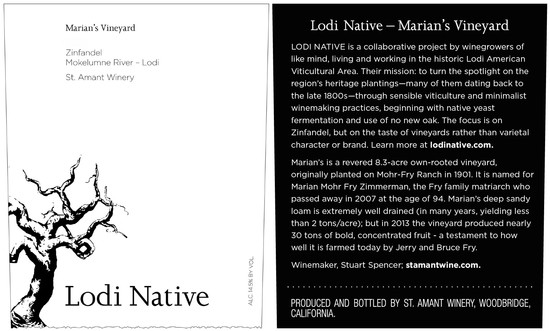
Front and back label of Lodi Native Marian's Vineyard Zinfandel, crafted by St. Amant Winery.
2014 Lodi Native (by St. Amant Winery), Marian's Vineyard Mokelumne River-Lodi Zinfandel⏤Seems to be reaching a peak, while showing fragrant vestiges of youthful berryish fruit; its now-modest tannin structure, nicely rounded, holding up a moderately intense varietal profile.
2019 Lodi Native (by St. Amant Winery), Marian's Vineyard Mokelumne River-Lodi Zinfandel⏤At five years, a rounded, sweetly fruit-scented, mildly earthy and tea-like Zinfandel hitting something of a "sweet spot" in its maturation curve. Will this middle-aged wine go further? The mild tannin and acidity don't seem to be indicative of that, but does it really matter? This wine is perfectly delicious now.
1997 Turley Wine Cellars, Spenker Ranch Mokelumne River-Lodi Zinfandel (magnum)⏤A "shocker" because this is a west side Lodi Zinfandel (a part of the appellation known for plump, weighty styles of wines that are typically appreciated super-young), yet is still tasting limber and firm, like a sleek and slim 70-year-old marathoner. Better yet, earthy/loamy notes peek out of faded, tea-like berry scents, still proudly showing its "sense of place" in Lodi's Mokelumne River Viticultural Area.
1997 Turley Wine Cellars, Dogtown Vineyard Clements Hills-Lodi Zinfandel (magunum)⏤That this 27-year-old wine is still bright and zesty is, perhaps, not a surprise to Lodi insiders because this vineyard has long been known for acid-driven wines that keep on "pushing." It is indeed on the "old" side, nutty and mildly beef-brothy, but the palate feel is still lively, even expansive, in the mouth.
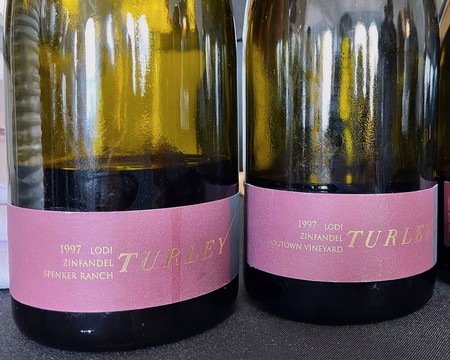
Second, notes on the wines—a mix of Zinfandels, Chardonnays, Barberas and a Cinsaut—tasted after our roundtable discussion, alongside exquisite courses prepared by Chef Ian Bens of Wine & Roses Hotel's Towne House Restaurant:
2003 The Lucas Winery, Lodi Chardonnay⏤Absolute revelation with the chef's Northern California black cod balanced by a silky/citrusy Clementine hollandaise with pear tendrils and local asparagus (i.e., "Delta grass"). After over 20 years, the wine's Chardonnay fruit character is still pure, ringing, honeyed, completely intact, sliding into crackling, creamy textures on the palate, fresh as the day this wine went into bottle
2015 The Lucas Winery, Lodi Chardonnay⏤At over 10 years of age, still fresh, fragrant, youthful, thanks to a consistent house style entailing early picking (to achieve alcohol levels in the 13% range), restrained oak influence (barely perceptible, even when wines are young), partial steel tank fermentation and suppression of malolactic fermentation, underlined by the wine's pinpoint balance and crispness on the palate.
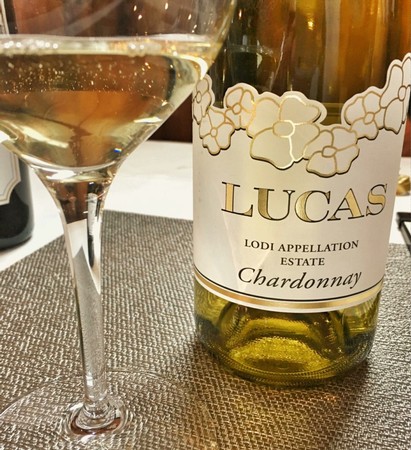
The Lucas Chardonnay. pullthatcork.com.
2008 Turley Wine Cellars, Bechthold Vineyard Mokelumne River-Lodi Cinsault⏤This winery's very first rendering of this revered vineyard (the oldest in Lodi, planted in 1886) is amazingly fresh, fragrant, fine and lively on the palate; the pure, unadulterated spiced cranberry/strawberry perfume retaining a quiet yet still distinctively delineated volume. Testament to the longevity of wines made from ancient vines—even when starting off with a negligible tannin structure—and equally amazing with the chef's ahi tuna tataki underlined by citrusy/herby touches of ponzu and shiso.
2006 St. Amant Winery, Leventini Vineyard Jahant-Lodi Barbera⏤At 17-plus years, this wine has reached a lean and lanky stage; still has good "bones," but the lack of stuffing teaches us that maybe we should keep Barbera for 10 to 12 years at the most.
2014 St. Amant Winery, Leventini Vineyard Jahant-Lodi Barbera⏤Coming up on 10 years, striking more of an ideal balance, in this Barbera's zesty, lively edge; fadingly berryish, mildly earthy fruit connecting with the chef's lean yet earthy/snappy dish of chicken mushroom roulade in sour cherry jus, spring peas and anise herbs. A "drink now" red.
2010 Turley Wine Cellars, Dogtown Vineyard Clements Hills-Lodi Zinfandel (magnum)—Spectacular shape, still concentrated in red berryish/tea-like perfume, lots of zesty acidity keeping the pure fruit profile bright and energetic. In fact, another 10 years would not be problematic for this wine, representing a vintage that the winemaker (Tegan Passalacqua) claims was the best of the over-thirty different vineyard-designate Zinfandels this winery made that year. More than up to a restrained yet beefy/earthy dish of grass-fed tenderloin tinged by thyme and peppercorn jus.
2012 Turley Wine Cellars, Kirschenmann Vineyard Mokelumne River-Lodi Zinfandel (magnum)⏤The first vintage of Kirschenmann after Passalacqua purchased this vineyard; still floral, fragrant, somewhat delicate (yes, Lodi Zinfandel can be very delicate), while showing dried flower and softening sensations indicative of a bottle now headed towards the back-side of its maturation curve. Right this moment, though, a complete joy.
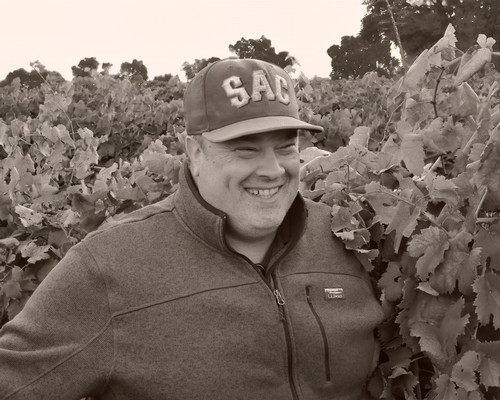
Turley Wine Cellars Tegan Passalacqua in Lodi's Clements Hills AVA.
The winemakers and journalists talk about the old Lodi bottlings
Heather Pyle (The Lucas Winery): In the late 1970s, Mike Phillips [founder of Lodi's Michael David Winery], Steve Borra [Borra Vineyards] and David Lucas [founder, The Lucas Winery] all started up their wineries around the same time, each of them trying to figure out what a barrel is for. David was a vegetable broker in the area who got into the wine growing business after answering an ad put out by Woodbridge Winery looking for a grape buyer.
The 40-acre Lucas property was purchased in 1978. The oldest Zinfandel block, behind the winery, consisted of 3 acres of own-rooted vines [now called ZinStar Vineyard], which has been farmed organically since 2009.
In the beginning, David made the wines himself [between 1978 and 1997]. The Zinfandels were non-inoculated, and he set the style that I followed after arriving in 1998. They're always meant to be food-friendly, with crisp acids and alcohols down around or below 14%; bottled unfiltered, usually spending about 11 months in oak, 25-35% new.
Being more conservative, I started to inoculate with yeast, even though I came out of Robert Mondavi where most certainly many of our wines were native yeast fermented. David was an artist, but he would make some terrifying wines⏤some lower in alcohol, some higher, all over the board⏤and I came in trying to stabilize the style. Yet that style has always been driven by the vineyard, which seems to want to make a more delicate, almost Pinot Noir-like Zinfandel.
As far as the 2010 ZinStar goes, the wine is every bit as fruit-focused as I hoped. It's quite remarkable. I like the spice. Sometimes we get a little tomato character in our Zins, but this wine is more fruit-forward and has more bone on the palate than most of our vintages.
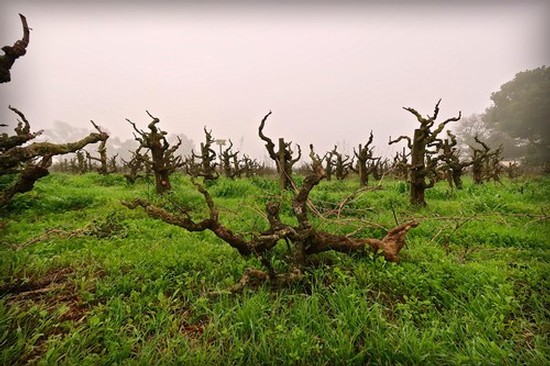
Fallen soldier in The Lucas Winery's ZinStar Vineyard, planted in 1933.
The 2000 is a little brickier in color. It's showing its age with a little soy and a little leather. When we do retrospectives, we tend not to go back further than this. At over 20 years, wines show more bottle variability; yet generally speaking, the older the wine, the more delicacy you get, which typifies the vineyard. The 2000s is at an age where it has lightened to the point of becoming very feminine. It's a pretty femininity, even though it's showing its age.
Stuart Spencer (St. Amant Winery): Vintages in Lodi matter. 2010 was a very cool vintage. A few years after the 2010s were bottled, we got together to taste of all the major 2010 Zinfandels from Lodi. I remember the wines as showing a great deal of promise, coming from a cool climate vintage, which the 2010 Lucas confirms.
Tegan Passalacqua (Turley Wine Cellars): In 2010 our best Zinfandel from out of the entire state came from Lodi. People still don't believe me when I say that, asking "Really?" That vintage was a magical thing for us, and I agree with Stuart that the 2010 Lucas falls right in line.
Heather Pyle: We typically pick in mid-September, which in 2010 was probably a lot earlier than most wineries.
Stuart Spencer: Going over the St. Amant wines, our story starts in 1996 when my dad [the late Tim Spencer] moved us to Lodi from Amador County, after making wine there starting in 1980. At the time, phylloxera had started to impact our vineyards in Amador, which necessitated the change. In Lodi, Lucas Winery and Michael David were around, and Jessie's Grove was just getting started. Other than that, there wasn't much more in terms of small wineries in Lodi.
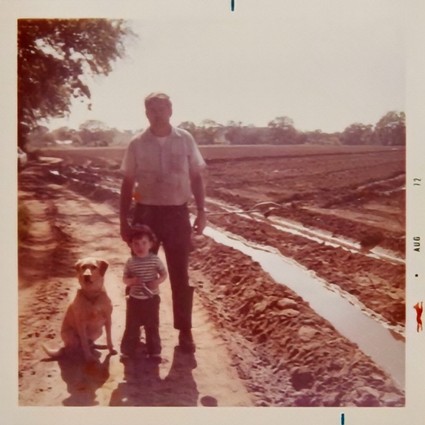
St. Amant Winery founder Time Spencer with Stuart Spencer in the early 1970s. St. Amant Winery.
When my dad got to Lodi he connected with Mohr-Fry Ranches looking for Zinfandel. He asked [Mohr-Fry owner] Jerry Fry, "What's your best vineyard?" Jerry got him started on Marian's, an 8.3-acre block planted in 1901. For some reason long lost in time, Marian's is a 100% Zinfandel block, with no mix of other plantings.
Anyway, he told Jerry if you do everything you can in the vineyard and we do everything we can in the winery, together we can help put Lodi on the map.
In regards to the 2001 St. Amant Zinfandel, back then we were picking around the third week of September. As climate change has come about, pickings have moved to around Labor Day [the first Monday of September] or pre-Labor Day, as early as August 25. Now, instead of one picking, we'll go out and do a first picking, 3 or 4 tons to see where a vineyard is at. Based upon that, we'll schedule out the rest of the picking, usually over 10-14 days.
My dad was still making the wine in 2001, and he always inoculated and kept Zinfandel in barrels for about 11 months, bottling just before the next harvest.
Older bottlings are always an adventure. One bottle will taste one way, another bottle another way, even though both are stored in the exact same place. But for me, they're always a window into where you were in life at one point. You ask, "Where was I at in September of 2001?" Of course, that was when 9/11 happened⏤we probably picked about a week after that unforgettable day.
The 2014 Marian's, by way of contrast, was 100% native yeast fermented. The bottling we're tasting was part of the Lodi Native project, which was 6 winemakers getting together to produce site-specific old vine vineyard-designated wines, following the exact same protocols: All native fermented, no new oak, no additives, enzymes, acids, filtration, or anything that might keep a Zinfandel from expressing its site.
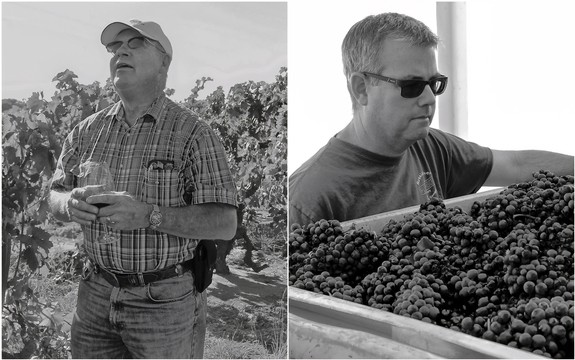
Mohr-Fry Ranches' Jerry Fry (left) and St. Amant Winery's Stuart Spencer.
Some of the Lodi Native winemakers at the time came from a place that was very much in the other camp. Most of them were almost sure that the entire project would turn into a disaster. Ultimately, though, it turned out to be one of the best PR projects we've ever done. The Lodi Native wines were all packaged in the same box, presented in media and trade tastings, and sold as 6-packs at the Lodi Visitor Center so consumers could taste them all together and make comparisons between the different vineyards.
I like the way the 2014 Lodi Native is tasting today. It still has a freshness of fruit to it. The bottling came from an earlier picking and was all done in macro bins [i.e., open-top containers], although native ferments can get scary. You bring in the fruit early in the morning when the temperature is still cool, but the fruit will often still sit and mock you for 4, 5, 6 days doing absolutely nothing except maybe start to smell a little weird. You want to do something about it, but all you can do is walk away and wait for it to start fermenting on its own. But it's during those "weird" stages that the wines probably develop their aromatic complexity.
Because of the differences we've found in native yeast wines, these days about half of our lots are fermented natively. While we stopped bottling Zinfandels under the Lodi Native label last year, this year's Marian's is 100% native.
We make the call on what gets inoculated and what gets fermented natively based upon what's happening in the vineyard and in the winery as they come in. Last year [2023] we had a lot of challenges with grape rot from the cool year and moist weather, so some lots were inoculated and others were not just because when your livelihood depends upon it you can't have too many lots going sideways on you.
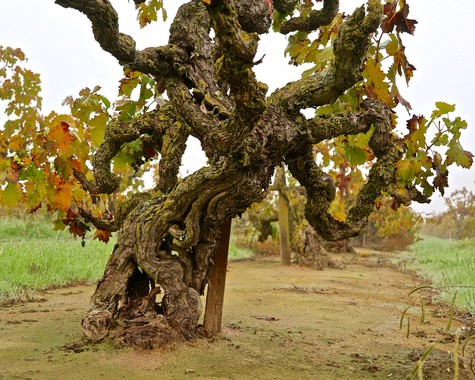
Own-rooted Zinfandel in the historic Marian's Vineyard, planted in 1901.
Looking at the 2019 Lodi Native, as a matter of personal preference I like a Zinfandel in the 5-to-10 year window, when there is still more fruit expression. After that time frame, wines can be more of a novelty. The 2019 is in a really good spot right now.
When it comes to barrels, we get optimal expression of fruit when aging in 3- to 4-year-old barrels, when they are considered "neutral." Sometimes when you use really old barrels it creates a homogenizing effect on wines, so that's not quite so optimal. When barrels are too new, the oak can exert some undue influence on the wine. At 3, 4 years old, the barrels give a fresh, fruit-driven expression of the wine.
Tegan Passalacqua: I've been with Turley since 2003. The winery was started by Larry Turley in 1993 after the ending of his partnership at Frog's Leap Winery, although he continued to own half of Frog's Leap up until 1997.
When he established his own label, Larry focused on Zinfandel and Petite Sirah, primarily from old vine vineyards. My joke about it is that Larry was always an ER doctor who thought he could save everything, so he was really attracted to old vines in danger of being pulled out.
Larry and John Williams [i.e., co-founders of Frog's Leap Winery] were among the first to champion organic farming in Napa Valley, willing to pay growers bonuses for organic grapes.
In the mid-1990s my [Turley winemaker] predecessor Ehren Jordan, who started out at Joseph Phelps Vineyards, left to do some work in the Northern Rhône. The guy who was the viticulturist at Joseph Phelps back in 1991 happened to be someone named Markus Bokisch [owner/grower of Lodi's Bokisch Vineyards]. They had both moved to Europe around the same time⏤Markus in Spain, Ehren in the Northern Rhône⏤and they kept in touch when over there, even spending holidays together.
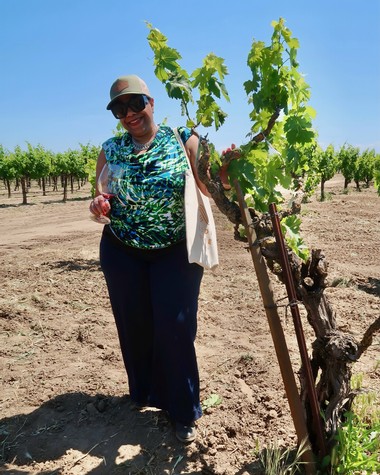
Wine Enthusiast's Tonya Pitts in Lodi's venerated Bechthold Vineyard, planted entirely to Cinsaut in 1886.
In 1996 Markus was back in California, working for Duarte Nursery. When he was selling Chardonnay grapes at a vineyard that is now known as Jessie's Grove in Lodi, he came across some very old vines that the owner said he'd be tearing out. Markus said, "I know people who would like this Zinfandel." They said, "Well, it's going out unless you can find someone who can give us at least $1,200 a ton for these grapes.
Markus went into their office to borrow their rotary phone, and he dialed up Ehren at Turley and said, "There's this 1889 Zinfandel vineyard at a property where I'm selling Chardonnay... they're about to tear it out, unless someone shows some interest in it." I think Ehren was out there the very next morning to look at it. He made a deal, and because of it, that vineyard, now known as Royal Tee [today, bottled under the Jessie's Grove and Marchelle brands], is still there today. It's the oldest Zinfandel left in Lodi.
Turley only made a Spenker Ranch [synonymous with Royal Tee Vineyard] in 1996 and 1997. After that, the [Spenker] family decided they wanted to start their own winery and take all the fruit for themselves. But it's something I feel really proud of. Larry and Ehren really made a difference. It's a vineyard that would no longer be there if they weren't there to save it.
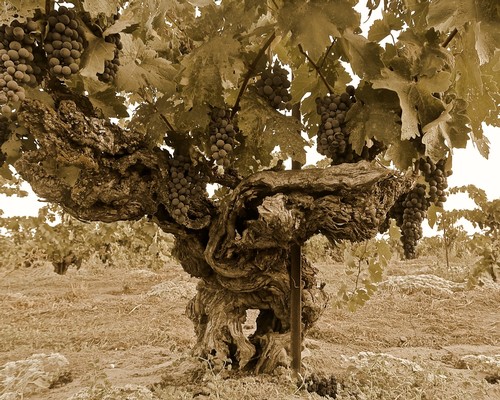
Kirschenmann Vineyard; own-rooted Zinfandel planted in 1915.
In 1997 we also started making a Dogtown Vineyard Zinfandel, located in the Clements Hills of Lodi. We still lease that vineyard today, and it's one of our oldest relationships, going on 27, 28 years. Dogtown has been farmed organically since 1997.
1997 was the only year when we made both a Spenker Ranch and Dogtown Zinfandel. The crazy thing to think about Dogtown [planted in 1944] is that it was only about 50 years old when we first started working with it. In other words, it wasn't crazy old, back in 1997.
Both these '97s were fermented on native yeast, like all Turley wines. We only have 2 cases of each, both of magnums, left in our library. I broke into the second-to-the-last cases to get the bottles for this tasting, but it's exactly for tastings like this that we set aside bottles in our library.
The Spenker Ranch is located right next to Heather's vineyard [i.e., The Lucas Winery's ZinStar Vineyard], and you can sort of taste it as having a similar lineage. The difference is that it's a mixed grape field. In 1997 Turley took the entire block, made up of mostly Zinfandel and quite a bit of Carignan as well as some Mission, Black Prince and Flame Tokay. I love the way the '97 Spenker puts it all together. The wine could have another 10 years of life left!
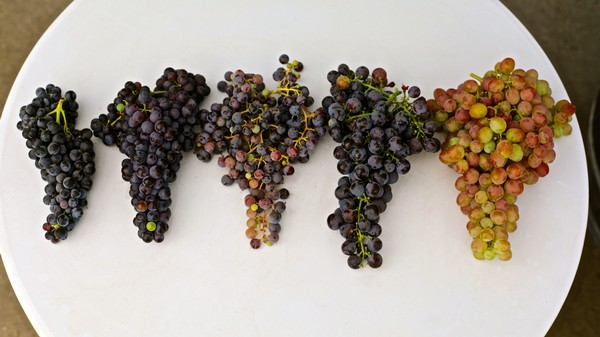
The grapes cultivated in Jessie's Grove's Royal Tee Vineyard, all go into Turley's 1997 Spenker Ranch Zinfandel: (from left) Zinfandel, Carignan, Mission, Black Prince and Flame tokay.
The '97 Dogtown, on the other hand, is 100% Zinfandel. There are a few Flame Tokay vines in the field, but I always say that Flame Tokay plantings in old vine Zinfandel fields were the Gatorade of its time⏤they were there for the workers to eat during the harvest. It's a beautiful table grape, not really meant to be fermented into wine.
These wines are important to me personally because they were what made me want to find my own property in Lodi. When I started coming out here in 2003 for Turley I fell in love with the place. Then to see the wines in the cellar as older vintages... when I started out with Turley they were only about 5 years old. I remember trying them, thinking, "These are beautiful wines." Today, they are more beautiful than ever!
Heather Pyle: What I love about the two Turley Zinfandels is that they are so different from each other, yet come from the same vintage. They have really retained their sense of place, which is really what it's all about.
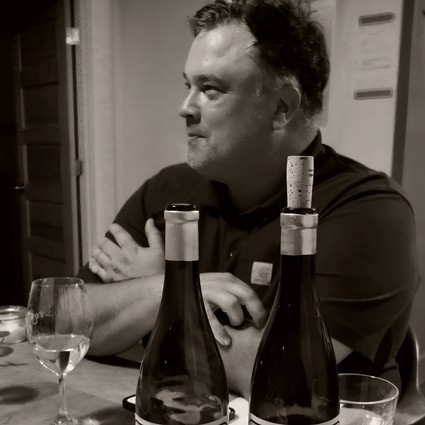
Turley Wine Cellars' Tegan Passalacqua.
Tonya Pitts (Wine Enthusiast): When I taste them, I taste "history." Looking at the 2000 Lucas, for instance, it is more like drinking older Pinot Noir. They are not really claret-like [i.e., similar to Cabernet Sauvignon-based reds], and not even what you expect out of Zinfandel!
Stuart Spencer: The interesting thing is, if you were served these wines without knowing what they were, would you guess they were Zinfandels?
Anna-Christina Cabrales (Wine Enthusiast): That's what I enjoy about these wines. As I keep going back to wines like the 2000 or 2010 Lucas, I wouldn't be sure what it was if I didn't know.
Tegan Passalacqua: I think, at least for the 1997 Turleys, if I was tasting them blind I would guess that they come from the Southern Rhône. The come across as more like older Grenache-based reds. I agree with Heather that the two Turleys are different from each other, but the thing about them as Lodi Zinfandels, just as I find in older Southern Rhônes, is they have green or black tea aromatics. It's a signature for me, especially for Lodi Zinfandel which isn't over-oaked or overripe. It's something of an herbaceousness, but a beautifully distinct herbaceousness.
Tonya Pitts: In the past, when tasting older Zinfandels, I've found that they start to taste more like Italian reds, and bear less and less resemblance to California Zinfandel.
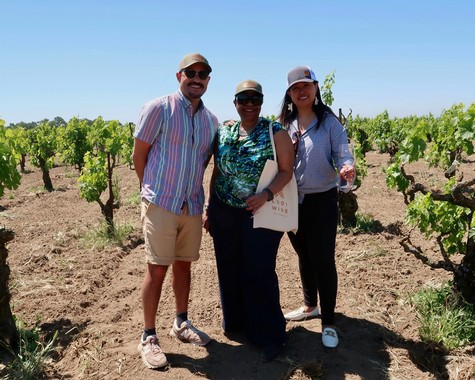
Wine Enthusiast's Tonya Pitts, Anthony Eyzaguirre and Anna-Christina Cabrales in Lodi's Bechthold Vineyard.
Anna-Christina Cabrales: As an expression of Zinfandel, I can appreciate the youngest wine, the 2019 Lodi Native. But I love it that the '97 Spenker Ranch takes on another identity. To me, it reminds me of a developing Barolo [made from the Nebbiolo grape]. And the '97 Dogtown, maybe an older Brunello di Montalcino [made from Sangiovese]. Some of the other older wines even remind me of an aging Chinon [Cabernet Franc] in terms of their spice or herbaceousness.
Stuart Spencer: It's fun that, as these Zinfandels get older, it gets harder to pinpoint their country of origin. I think I would also think they were more like Italian or South of France wines, if I didn't know what they were.
Tegan Passalacqua: The other thing blowing my mind, going back to taste the 2000 Lucas and 2001 St. Amant, is that these wines were made in a different world⏤a world kids today would never recognize. I get goosebumps thinking about it, especially since 9/11. It'a like the world has experienced a loss of innocence, ever since then.
Looking at these wines from a historical perspective, I like to believe that the reason Zinfandel caught on so well in California over 100 years ago is because we are a state, or country, of immigrants. There's something familiar to wines made from these grapes, which comes out especially as they get older, or when they're made from very old vines.
It's something most of our own industry has shied away from in recent years. When my boss's wife [i.e., Suzanne Chambers], who imports wines, hosts visitors from Burgundy in France, and I'm compelled to show them around town [in Napa Valley] for a little while, I find that they have little interest in California wines made from Pinot noir or Cabernet Sauvignon. All they want to do is drink Zinfandel and go to Gott's [Roadside] to have a burger! In a manner of speaking, they're not interested in cheap American knock-offs of their own wines.
Zinfandels are our own thing, yet we still haven't done a good job in America of branding that.
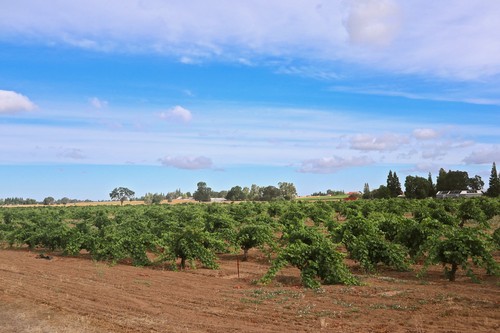
Clements Hills-Lodi's Dogtown Vineyard, planted in 1944.
Stuart Spencer: We talk all the time about how Zinfandel is the quintessential California wine, and how it really should be something we put on a pedestal. But some of the most expensive Zinfandels are, at the most, $75.
Tegan Passalacqua: We recently raised the price of our Hayne Vineyard Zinfandel from $75 to $78, the first time we've done an increase in something like 26 years. Yet the Hayne sits right next to Spottswoode in St. Helena, Napa Valley, right there in the middle of vineyards producing $200, $300 Cabernets. We pay $10,000 a ton for this Zinfandel. We should be charging more like $200 or $300!
Stuart Spencer: There's a ceiling for Zinfandel, but not when it comes to popularity. It's well known that Zinfandel is one of the best selling DTC [i.e., direct-to-consumer] varietals, right up there with Cabernet Sauvignon and Pinot Noir.
Tegan Passalacqua: Turley holds its wine club pick-up at our tasting rooms in Paso Robles and Amador County. One thing I always notice about our customers at the parties is they are not wine snobs. They are more like true wine enthusiasts. They're having fun, not like customers at Cabernet pick-up parties where everyone is checking out each other, seeing who's worthy of being there, or talking about scores. Zinfandel lovers are the opposite.
I'm hoping that there will come a time when old vine vineyards will be treated the same way every other country treats their best vineyards. I personally think Lodi's oldest vineyard [i.e., Bechthold Vineyard, planted to Cinsaut in 1886] should be the first vineyard in America named as a World Heritage Site. I don't know how we'll get that done, but to me it's justified, it's such a magical site.

The Turley block in Lodi's Bechthold Vineyard, Lodi's oldest and most historic vineyard.
Randy Caparoso: At least, in 2014, the Bechthold Vineyard was named the California Vineyard of the Year by the California State Fair. But you're right, Bechthold should be treated like any other exalted vineyard in the world, like a Clos de Vougeot in France. Given the vineyard's age and the rarity of its grapes, its wines should also be selling for $200.
Tegan Passalacqua: At the last Historic Vineyard Society tasting in San Francisco, one winemaker's husband was saying that he believes all the old vine wines should charge a dollar for every year of the age of each vineyard site⏤at least in a more perfect world.
Sara Ventiera: I'd love the chance to expose our readers to more of this in the future. I think the history of vineyards and regions is every bit as important as the wines themselves. I also love the World Heritage Site idea. It will be important to tie in the importance of these vineyards in some way, shape or form.
Anna-Christina Cabrales: The valuable thing about the experience of these older bottles, for us as a team, is that we are now cognizant of these wines. I think the history of especially the old vine vineyards should be factored into our choices of what to highlight, even when considering lists such as "Best Wines of the Year."
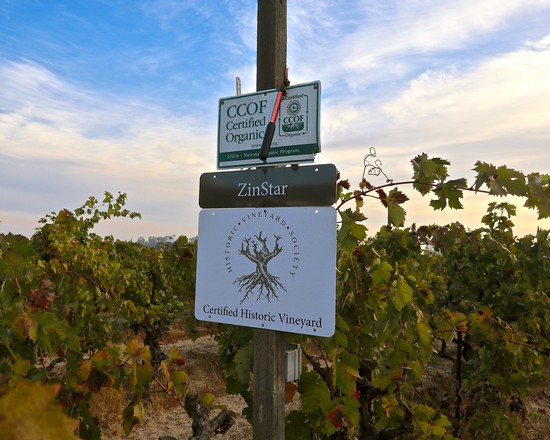
Certified organic and Certified Historic Vineyard signs in The Lucas Winery's ZinStar Vineyard.